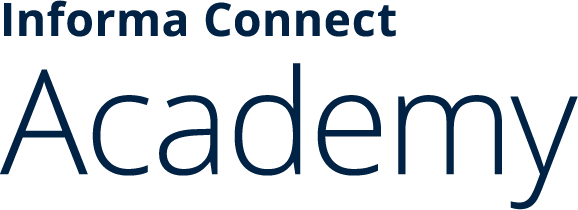Which brands and billionaires are on track to hit the trillion-dollar valuation next?

‘What does it feel like to know you’re worth more than a billion dollars? So good I could never possibly explain it.’ – entrepreneur Mark Cuban says in the official trailer for his Win Big in Business Master Class. Makes you wonder how someone leading a trillion-dollar empire feels, doesn’t it?
If you ever wish to ask, we’ve got a few prospects for you, including Satya Nadella, Tim Cook, Jensen Huang, and Sundar Pichai – all multi-billionaires in their own right and the current leaders of trillion-dollar businesses. You can also ask them the more important question: How does an enterprise grow to become a trillion-dollar titan?
We’re sure they’ll tell you the answer is in R&D and L&D – that is, product improvement and employee growth. Research and development ensures product innovation and competitive edge. However, it’s learning and development that enables everything else, even R&D.
L&D equips employees and builds capacity. It upgrades employee skills so they’re more creative, efficient, effective, and productive. Look under the hood of a trillion-dollar organisation, and you’ll see L&D driving business results — as we’re sure the heavyweights in the list below will confirm.
Trillion-Dollar Businesses
Here’s a little exercise. Think of an enterprise you consider to be at the pinnacle of success. It’s a certainty you’ll mention at least one of the trillion-dollar companies.
If business were an aristocracy, trillion-dollar organisations would be royalty. The following are the seven companies that have attained a trillion-dollar market cap valuation as of July 2024
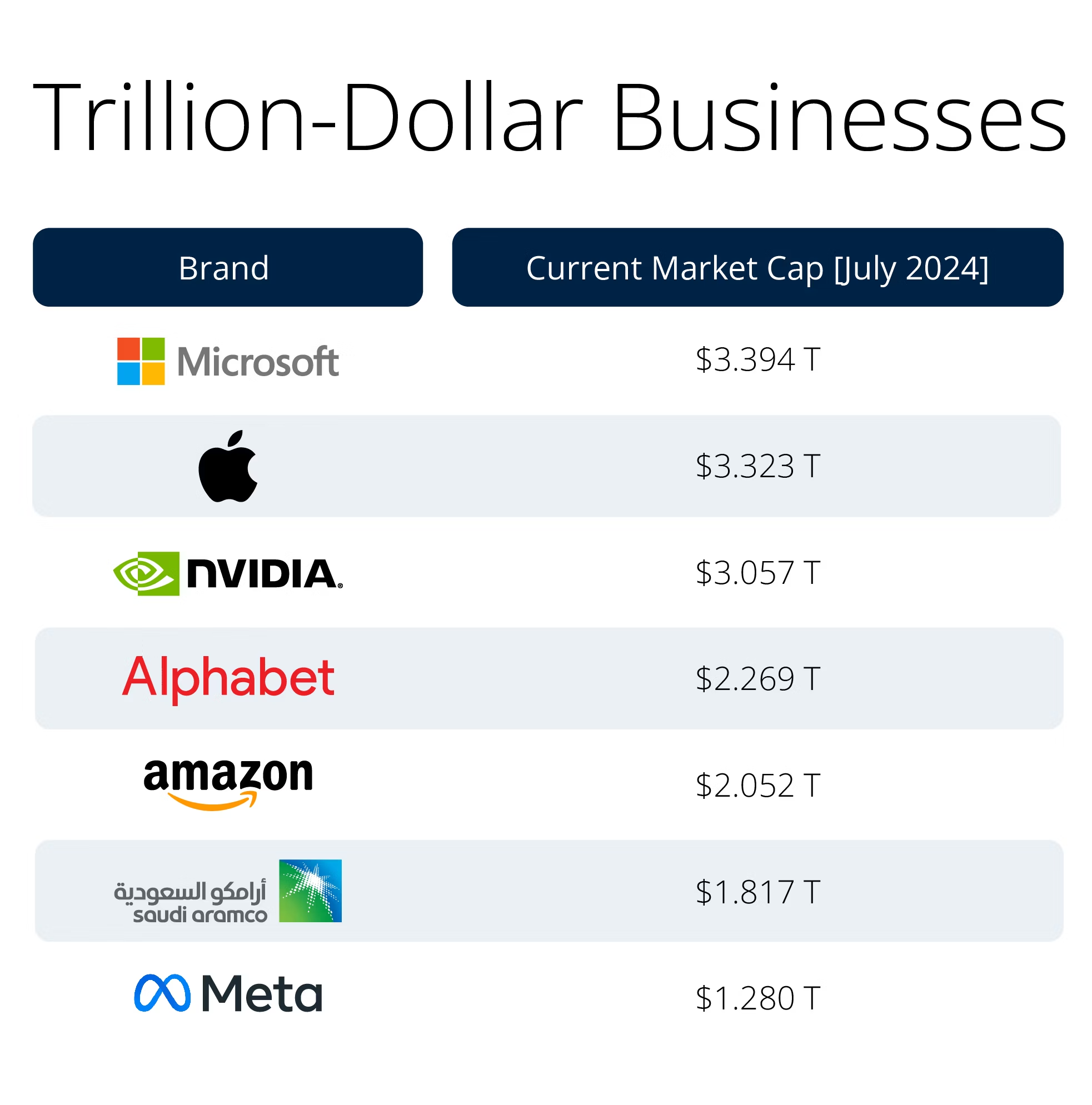
1. Microsoft
American software company Microsoft, headquartered in Redmond, WA, lands in top place with a market cap of $3.394 T. Microsoft first joined the trillion-dollar club in April 2019, becoming the third U.S. company to ever reach this milestone.
Microsoft Corporation makes platforms and tools powered by artificial intelligence (AI) that serve personal and business computing needs. Microsoft’s story began in 1975, founded by Bill Gates and Paul Allen. By 1981, their operating system became the default OS of IBM personal computers. At year 11, Microsoft went public, reaching a market cap of $1 B and, by the late 1980s, it has become the largest company in the personal computer software development space.
Since then, Microsoft has continued to grow from strength to strength, expanding its core offerings from operating systems and productivity software to include:
- Search (Bing)
- Mobile phones (Windows Phone, Lumia)
- Communication (Lync, Skype, Yammer)
- Gaming (Xbox, Minecraft)
- Personal computer hardware (Surface)
- Wearables (Microsoft Band)
- Cloud (Microsoft Cloud)
- Enterprise resource planning (Microsoft Dynamics 365)
- Internet connectivity (Marea)
- Artificial Intelligence (OpenAI, Microsoft Copilot)
L&D at Microsoft
Empowering employees through learning and development is at the core of Microsoft’s growth strategy. According to Microsoft, they prioritise learning over knowing; thus, employees are encouraged and provided ample opportunities to become ‘learn-it-alls’.
Employees are notified of personalised and relevant opportunities available at the company’s learning platforms, including Microsoft Learning and LinkedIn Learning. Microsoft utilises a combination of methods, including in-classroom learning, on-the-job training, learner boards (peer) sharing, and worker buddies. Additionally, Microsoft uses real-time and asynchronous virtual learning strategies.
2. Apple
A market cap of $3.323 T lands Apple in second place. It surpassed $1 T market cap in 2018. While it was not the first global company to reach $1 T – that title belongs to PetroChina, which attained it in 2007 – it became the first to exceed $3 T in June 2023.
Apple opened its doors in 1976, founded by Steve Jobs and Steve Wozniak. It started as a manufacturer of personal computers, but it has since expanded its activities to include software development and the production of mobile phones and tablets, wearables and computer peripherals.
It blazed a trail of innovation with its graphical user interface and introduced the first touchscreen iPhone in 2007. While it was not the first touchscreen display (touchscreen tech was invented in 1965), the iPhone definitely made the tech mainstream.
Through the years, Apple has carefully designed, defined and policed its brand identity, successfully turning its brand into a household name and making its mark one of the most recognisable worldwide. Apple products have a cult following, particularly the iPhone and the Mac.
Apple’s retail arm is a primary contributor to Apple’s brand ascendancy. In-store employees are the face of the brand to customers, and Apple has a legendary 90% retention rate on retail store employees.
L&D at Apple
The key is continuous employee training and development. Apple has a flexible and accessible online training program. Employees start their day with the Hello application that focuses the employees’ attention on the most important updates for the day. They also have a Loop app where other retail employees can post insights and tips that their peers can learn from or emulate. The result of Apple’s retail employee training initiatives are empowered and customer-centric product experts.
Apple also has a supplier employee development drive. The tech giant has committed $50 M to support the L&D programmes of the International Labor Organization, the International Organization for Migration, and other education experts to support the learning and development of the people in their supply chains.
3. NVIDIA
NVIDIA, with a market cap valuation of $3.057 T, ranks third. This U.S. company was founded in 1993 by Jensen Huang, Chris Malachowsky and Curtis Priem. NVIDIA soon carved a niche for itself in graphics processing. Today, it is estimated that NVIDIA accounts for 80% of the global market share in global processing unit (GPU) semiconductor chips.
NVIDIA’s focus on graphics processing turned out to be a brilliant business decision. The demands of AI have given NVIDIA chips and systems a default role in AI engines. NVIDIA is pioneering accelerated and high-performance computing systems driving AI factories, revolutionising graphics processing, enabling digital twins, and facilitating digitalisation initiatives in the manufacturing, automotive, health, and other industries.
L&D at NVIDIA
NVIDIA is a firm believer in employee learning and development. In fact, this GPU enterprise has an active direct-billing agreement with the Stanford Center for Professional Development (SCPD).
Full-time, regular and active NVIDIA employees based anywhere in the globe may self-enrol in professional development courses or pursue graduate education. Professional development courses are available online and may be streamed on-demand. Graduate courses may be taken live or streamed on-demand. Graduate courses may count toward a degree, but employees may also choose the non-degree program option, in which case they will earn graduate certificates.
The Brands Set to Hit Trillion-Dollar Status
Nipping on the heels of the elite trillion-dollar giants are enterprises we predict will soon break through the $1 T market cap valuation ceiling. While there’s no guarantee they will — there are various factors at play — our evaluation of their trajectory so far indicates they will eventually cross over from the billion-dollar to the trillion-dollar business club.
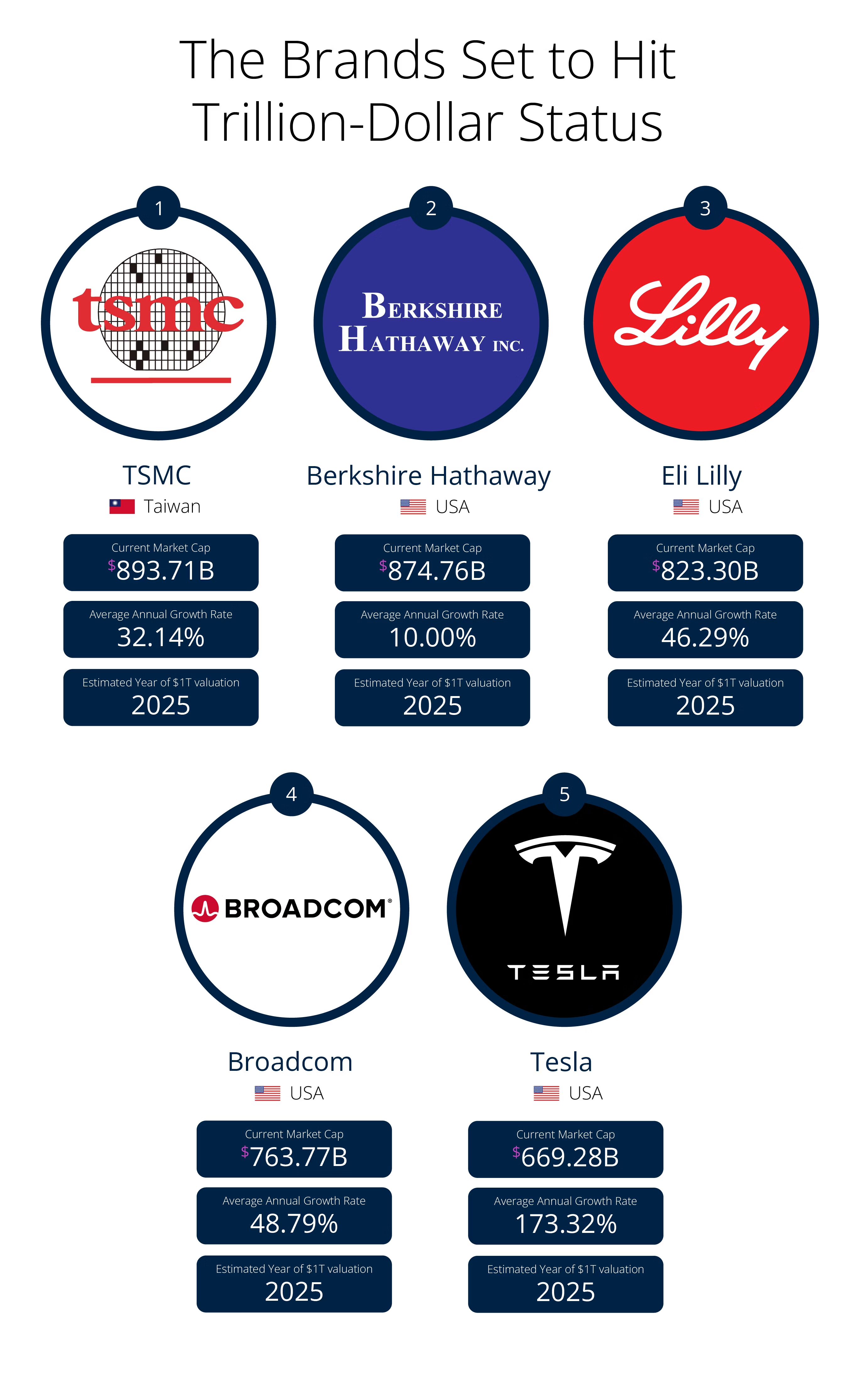
1. TSMC
Taiwan Semiconductor Manufacturing Company is the third-largest manufacturer of semiconductors in the world; the first and second spots go to Intel and Samsung, respectively. This Taiwan-based company was established in 1987, the first to create a dedicated semiconductor foundry. Today, the company has sufficient capacity to produce more than 16 million 12-inch equivalent wafers yearly.
TSMC has a market cap valuation of $893.7. At an average annual growth rate of 32.14%, it is expected to become a trillion-market cap company in 2025.
L&D at TSMC
TSMC, like the trillion-dollar hitters in the earlier list, clearly believes in employee learning and development. This semiconductor company has a talent development blueprint detailing its long-term (by 2030) goals and short-term targets. An annual average of 100 learning hours for employees is one of the company’s long-term goals.
TSMC’s talent development model clearly details how its L&D strategy is key to company sustainability. Individual L&D components include the following:
- Training and development available at all levels: There’s a systematic learning roadmap.
- A diverse and versatile learning approach: The company follows a 70-20-10 principle on learning activities (70% on experiential, 20% on feedback and coaching, and 10% on training program) and uses blended learning and AI adaptive learning.
- Ability-based learning programme: Follows the people development framework organisation development diagnosis.
2. Berkshire Hathaway
Berkshire Hathaway is a U.S. group of companies led by multi-billionaire Warren Buffett. It has a diverse portfolio of subsidiaries (more than 80) with business activities that include the following:
- Electric, gas and sanitary services
- Freight rail transportation
- Fire, marine and casualty insurance
- Manufacturing
- Retail
This conglomerate has the world’s most expensive stock, valued at more than $500,000 per Class A share (as of 2023). This high price is primarily a function of supply. Berkshire Hathaway Class A shares have never undergone a stock split and have relatively few shares outstanding. However, there is a more affordable class of Berkshire Hathaway shares. These Class B shares (ticker symbol BRK-B) were first issued in 1996 and have undergone a stock split in 2010.
Berkshire Hathaway has a market cap valuation of $874.76 B and an average annual growth rate of 10%. Based on its historical growth trajectory, it will join the exclusive trillion-dollar club in 2025.
L&D at Berkshire Hathaway
Berkshire Hathaway has a learning management system, the BHHC Academy, and it serves as their central platform for delivering training courses and programmes. The company also has an extensive learning library with hundreds of e-learning courses on a wide array of topics and a leadership development programme that combines theoretical discussion and hands-on learning exercises.
3. Eli Lilly
Eli Lilly is an American pharmaceutical and biotechnology company founded in the United States in 1876. It produces a wide range of medications for diabetes, cancer, neuro, immunology, bone, joint, obesity, and COVID-19 patients.
At its market cap valuation of $823.3 B and a hefty annual growth average rate of 46.29%, Eli Lilly is projected to become a trillion-dollar company by 2025.
L&D at Eli Lilly
Eli & Lilly builds employee capabilities in line with their roles; this is crucial in the highly regulated pharmaceutical industry. The company has an established professional development platform called Explore Your Career that provides tools and guidance for the development of skills and leadership qualities as well as thousands of on-demand business, technical and creative courses.
4. Broadcom
Broadcom is a technology company based in California. It established a name for itself through LED displays, fibre optic transmitters, semiconductors, infrared transceivers, optical mouse sensors, and cable modems. Today, it continues to deliver connectivity, mainframe, enterprise, and cybersecurity solutions.
Broadcom has a market capitalisation of $763.77 B. At a 48.79% average annual growth rate, it’s expected to surpass $1 T in market cap valuation by 2025.
L&D at Broadcom
According to 94.6% of Broadcom’s employees, Broadcom is a great place to work; likewise, 95.9% of employees say they are proud to work at Broadcom. One of the reasons is the company’s learning and development initiatives, including peer-to-peer mentorship (i.e., Lean In Circle) and a generous educational assistance programme.
Educational assistance is available to both part-time and full-time personnel. It empowers employees to decide their development paths by providing tuition assistance for academic classes or degree programmes, as long as such classes or degrees are work-related and can help enhance on-the-job performance.
5. Tesla
Tesla is an electric automobile, solar energy and power storage company based in the United States. It shot to fame with the launch of its first, all-electric sports car (i.e., the Roadster) and went mainstream with the Tesla Model S. Other products include powerwalls, megapacks, solar panels, solar roofs, and car chargers.
Tesla has a market cap of $669.28 B. However, its impressive growth rate, estimated to be growing annually at an average rate of 173.32%, means it should exceed $1 T in 2025.
L&D at Tesla
Tesla treats learning and development as an essential part of its growth and development as a company and a crucial part of its capacity-building. The Tesla START programme is proof of that.
Tesla START is an intensive training pathway delivered through partner institutions. It equips individuals with the knowledge, skills and certifications that will qualify them for an automotive, a collision or a manufacturing role at Tesla.
For employees, Tesla uses blended and mobile learning strategies. A combination of online and offline training is necessary for co-located work environments. Meanwhile, mobile learning is training delivered as and when needed - i.e., workflow-embedded learning experiences. It’s aligned with the concept of microlearning, which posits we absorb information better when it’s broken down into easily digestible units.
More Brands Set to Hit Trillion-Dollar Status
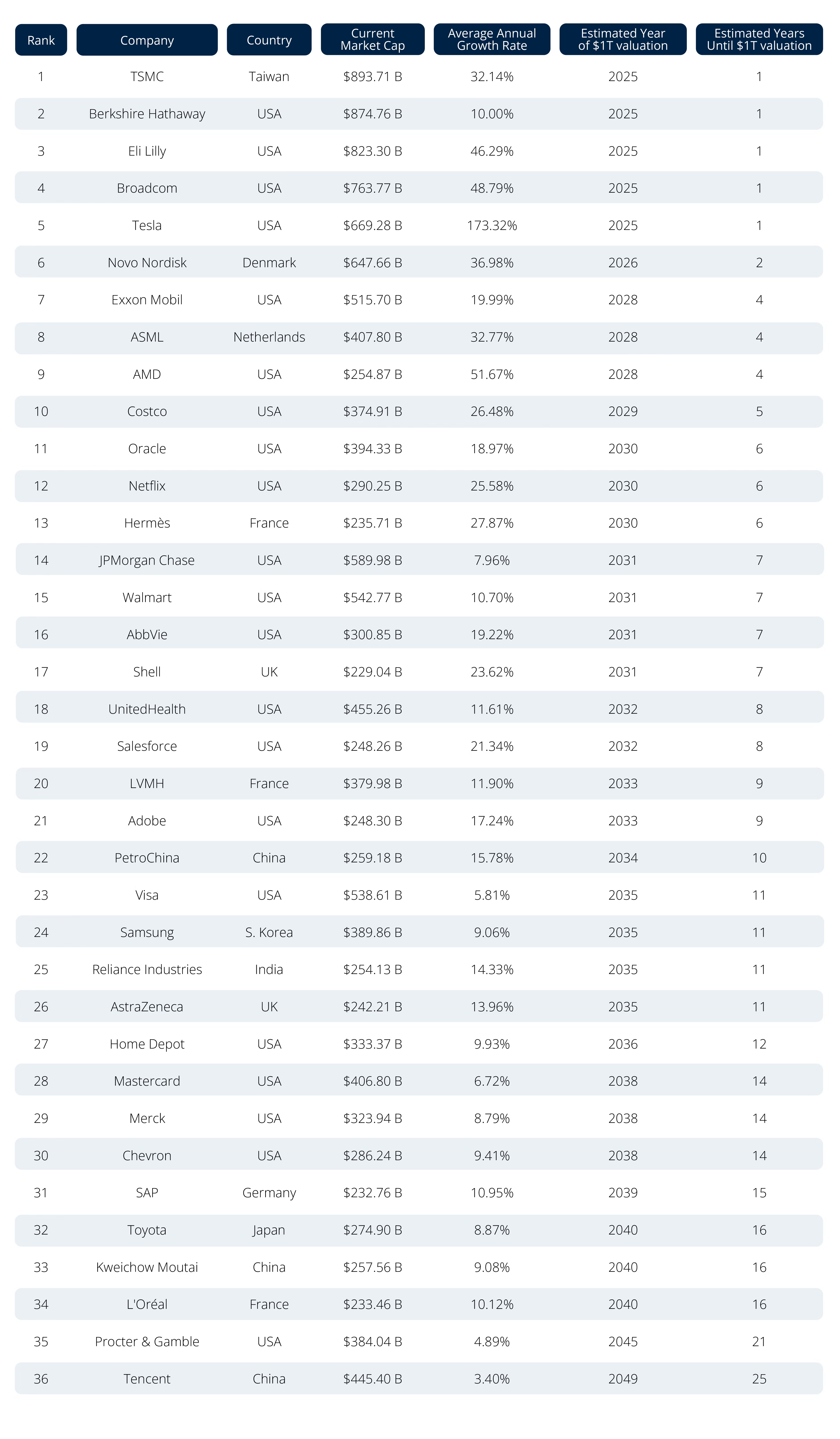
Creating a Trillion Dollar Company
The path to a trillion dollars is one rife with challenges and opportunities. To minimise the impact of the former and maximise the utility of the latter, an organisation must have driven and capable people.
As such, a company’s learning and development strategy is crucial to its growth, development and eventual success. The trillion-dollar companies above prove the value of learning and development initiatives.
The Training Industry Report predicted a 2023 total global L&D budget of $395.2 B. Trillion-dollar companies, in particular, are spending a fortune on L&D – a reflection of the value they find in developing and empowering employees in driving business growth. Amazon (top 5 in the trillion-dollar club) announced they’re investing $1.2 B in skills training programmes for their employees.
Microsoft has a multi-layered and nuanced L&D strategy. Employees are assessed by a Human Capital Analysis team to identify the specific needs of individual employees. Only then do they engage in training activities, ensuring a personalised and individualised approach for everyone.
Microsoft uses a combination of approaches: training courses, coaching/shadowing, off-the-job, and on-the-job training to equip and enhance the skills of employees. They start new employees off with foundational training courses to ensure a seamless transition from academic and theoretical knowledge to practical workplace skills.
Apple, which spent $50 M on its L&D department in 2022, has a remarkably thorough strategy. New employees get intensive core training in Apple products, solutions and other essential areas. Apple’s training programme called Pathways, and a social network (Loop) for peer-to-peer learning, systematically reinforce employee learning and development. In line with the fast-paced nature of the work at a tech company like Apple, employees take charge of their upskilling, reskilling and professional development.
NVIDIA uses a mix of coaching, feedback and role modelling for employee development. The company holds a Careers Week that includes training and upskilling sessions. Furthermore, employees get exclusive access to L&D courses supplied and curated by third-party providers.
From Billionaire to Trillionaire
No one in the world has claimed trillionaire status – at least not yet. However, there are some likely candidates. The following are multi-billionaires who will probably become trillionaires sooner or later.
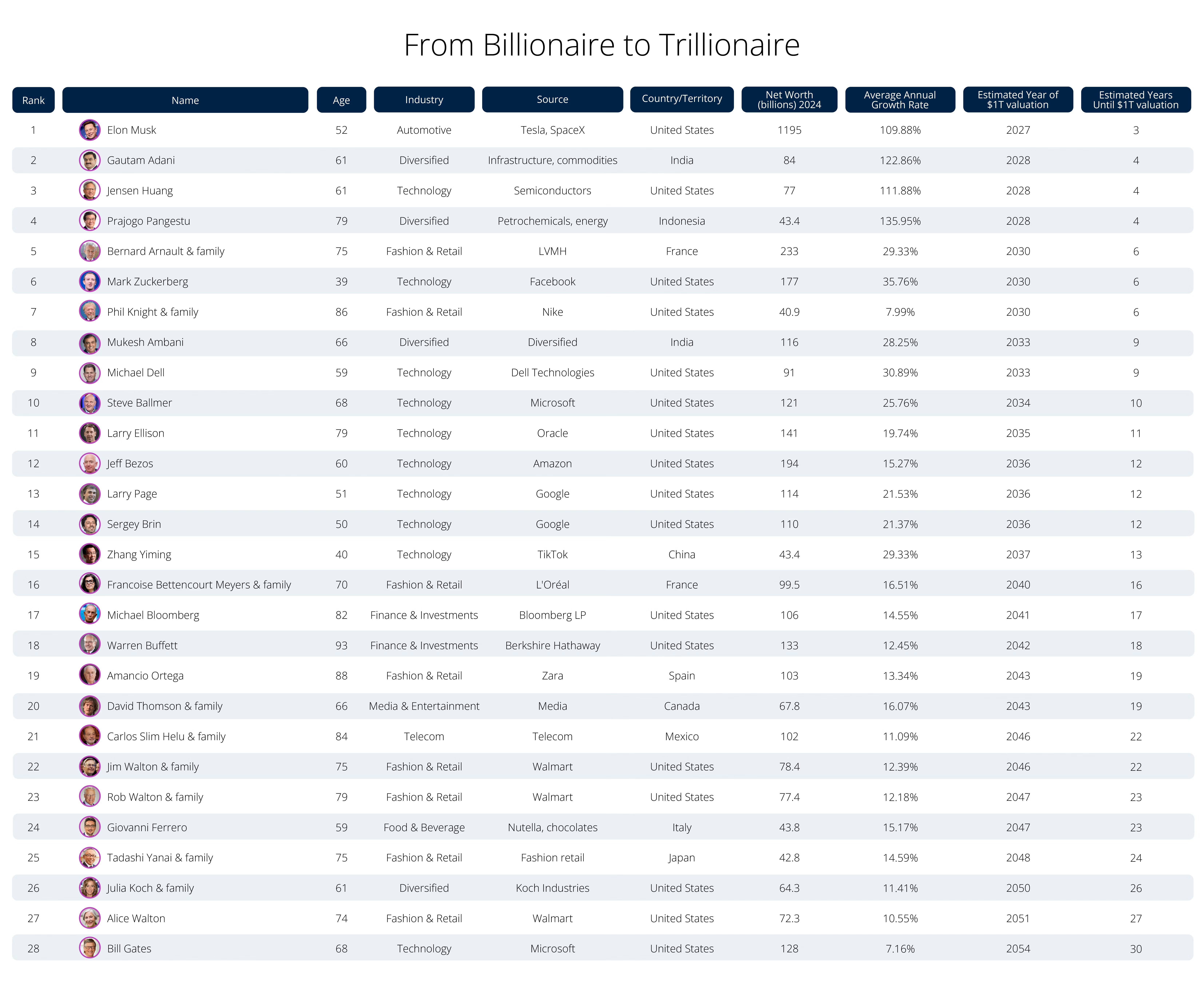
From Billionaire to Trillionaire
1. Elon Musk
expand_moreWho hasn’t heard of Elon Musk? He’s the founder of the rapidly growing automotive company Tesla, the manufacturer of advanced rockets and spacecraft, SpaceX, and the person you can thank (or blame) for Twitter’s rebranding to X.
With a net worth of $195 B, growing at an average rate of 109.88% every year, Elon Musk is the clear favourite to become the first trillionaire by 2027.
2. Gautam Adani
expand_moreGautam Adani is the visionary founder and leader of the conglomerate,Adani Group. Headquartered in India, Adani Group operates globally through various companies engaged in business activities that include:
- Power generation, transmission and distribution
- Ports and terminals, agriculture and general logistics, industrial parks
- Defence and aerospace incubation
- Airport management
- Water treatment
- Road and rail networks
- Data centres
- Farming
- Food manufacturing
- Real estate
Individual Adani subsidiaries have multi-billion market cap valuations, and Gautam Adani has an estimated net worth of $84 B and an average growth rate of 122.86% per year. He’s expected to become a trillionaire by 2028.
3. Jensen Huang
expand_moreJensen Huang, one of the founders of the trillion-dollar company NVIDIA and the only person to have ever served as NVIDIA’s CEO, is expected to become a trillionaire in 2028. He has an approximate net worth of $77 B and an average annual growth rate of 111.88%.
4. Prajogo Pangestu
expand_morePrajogo Pangestu got his start from timber in the 1970s. He grew this timber business into the Indonesia-based conglomerate Barito Pacific. In 2007, His company acquired 70% of Chandra Asri, a petrochemicals company with a current market cap valuation greater than $48 B. Barito Pacific is into petrochemicals, energy, real estate, logistics, and investments, among other interests.
Prajogo Pangestu has a net worth of $43.4 B and an average growth rate of 135.95%. His net worth is expected to be greater than $1 T by 2028.
5. Bernard Arnault and Family
expand_moreBarnard Arnault is the founder of LVMH Moët Hennessy Louis Vuitton (a.k.a. LVMH), the multinational company that owns renowned luxury brands, including:
- Louis Vuitton (fashion)
- Moët & Chandon (champagne)
- Hennessy (cognac)
- Tiffany (American jewellery)
- Dior (French fashion house)
- Fendi (Italian fashion house)
- Givenchy (French fashion and perfume house)
LVMH has a market cap valuation of $379.98 B and is 20th on our list of would-be trillion-dollar club businesses. Bernard Arnault and family has a collective net worth of approximately $233 B. At an average growth rate of 29.33%, they’re expected to be worth $1 T by 2030.
Women Billionaires
It’s worth noting the three women in the list of the 30 billionaires expected to breach the trillion-dollar mark by the middle of this century.
Francoise Bettencourt Meyers
expand_moreFrancoise Bettencourt Meyers is granddaughter of L’Oreal founder Eugène Schueller. She and her family have a net worth of $99.5 billion and own more than one-third of L’Oreal. Francoise is the chairman of the family’s holding company and continues to serve on L’Oreal’s board. She and her family are expected to attain a net worth of $1 trillion by 2040.
Julia Koch
expand_moreJulia Koch is the widow of David Koch, who co-owned the privately held company Koch Industries with his brother Charles Koch (also on this list). When David passed, Julia and her three children inherited his 42% stake in the company. They currently have a net worth of $64.3 billion and own 15% of the NBA's Brooklyn Nets. They’re expected to join the trillion-dollar club in 2050.
Alice Walton
expand_moreAlice Walton is the only daughter of Walmart founder, Sam Walton. She and the rest of Sam Walton’s heirs, including her siblings Jim and Rob Walton, have around a 50% stake in Walmart. With a net worth of $72.3 billion, she’s expected to become a trillionaire in 2051.
About Informa Connect Academy:
Informa Connect Academy is part of Informa, a global FTSE 100 business with a network of trusted brands in specialist markets and more than 11,000 colleagues working in over 30 countries. Informa Connect Academy leverages the expertise of Informa Connect to meet the needs and aspirations of students, industry professionals, and educational partners. Their purpose is to connect customers to information and people, enabling them to know more, do more, and be more. Informa is unmatched in helping people share professional knowledge worldwide.
Methodology
Brands
We looked at the world’s 50 most valuable publicly traded companies as of July 3rd, 2024, taking their market capitalisation as of this date, according to CompaniesMarketCap.com.
We then calculated the average of the annual growth rates recorded over the last five years by the same source and applied it to the current market cap to estimate how many years it would take each company to hit a market cap of $1 trillion, given its average rate of growth.
Business People
We took the net worth data of the top 30 wealthiest people in the world, according to Forbes, and logged the last six years of data, working backwards from the most recent to as far back as 2017. All data was retrieved on July 3rd 2024.
Out of these 30, we excluded those on whom no data is available for at least five years and, thus, for whom we cannot calculate a reliable annual average growth rate.
We then calculated the average growth rate per year for everyone in the resulting shortlist over the last five years and extrapolated this to yield 30-year forecasts. We used this data to predict who is likely to reach trillionaire status and in what year.
